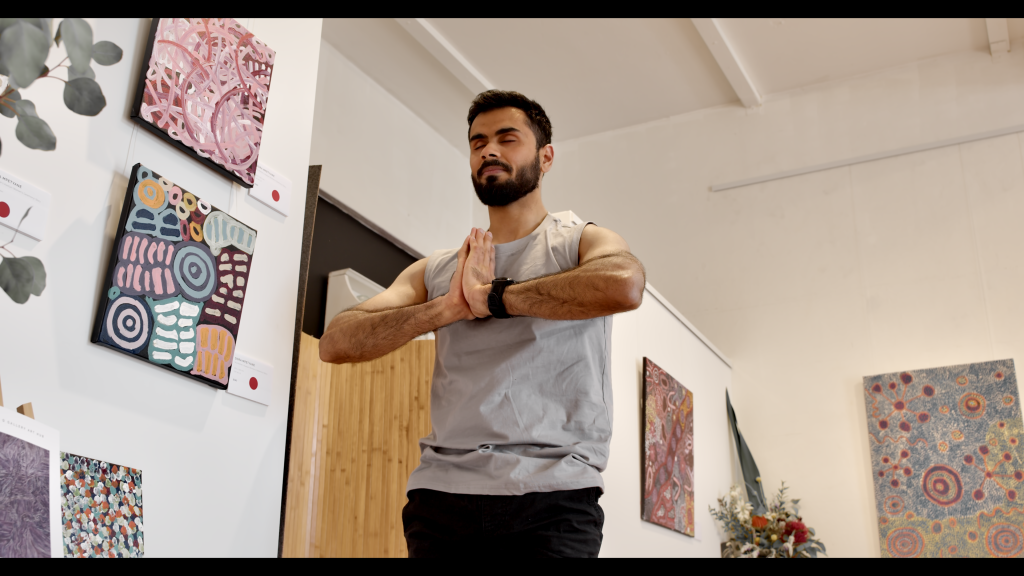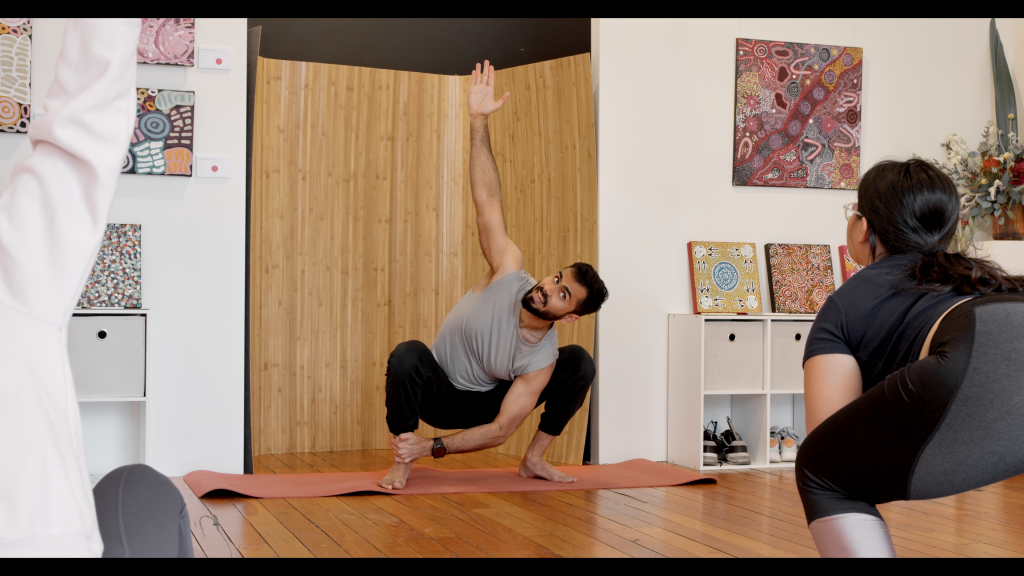Traditional Ashtanga and Hatha Yoga Classes
In Person / Online Group Yoga Classes
| Day | Time |
|---|---|
| Monday | 6:30pm – 7:30pm |
| Wednesday | 6:30pm – 7:30pm |
| Saturday | 10:30am – 11:30am |
- Join us for a rejuvenating 60-minute Traditional Ashtanga and Hatha Yoga class set in Canberra. This class is designed for all levels, whether you are a beginner or an experienced yogi looking to deepen your practice.
- Practicing Yoga will energize your body and enhance your physical endurance while strengthening your will and calming your mind. Practicing regularly will create a transformative experience for both your body and mind.
- We will explore a harmonious combination of Hatha and Ashtanga Yoga, focusing on Asanas (poses), Pranayama (breathwork), Pratyahara (sense withdrawal), Dharna (concentration) and Dhyana (practicing awareness with meditation).
- Whether you are seeking to improve your flexibility, strength, reduce stress, or simply enjoy some time dedicated to self-care, this class will provide the perfect opportunity to do so. Come join us and experience the benefits of Traditional Ashtanga and Hatha Yoga in a supportive and welcoming environment. Get ready to cultivate a deeper connection with yourself and create positive changes in your life.


Ashtanga Yoga, a deeply revered practice with its origins in ancient India, is attributed to the sage Patanjali, who compiled the Yoga Sutras around 400 BC. This comprehensive system, detailed through 196 Sanskrit sutras, was meticulously preserved and transmitted across generations through oral recitations, a testament to its sacredness and the reverence held by its practitioners. The essence of Ashtanga lies in the “Eight Limbs” (Ashta+anga), a holistic approach to achieving the union of body, mind, and spirit. Each limb serves as a step on the path to a state of complete awareness of the present:

Yama (Universal Morality)
The first limb emphasizes ethical standards and integrity, focusing on behaviors and habits necessary for a socially responsible and morally upright life. Key principles include Ahimsa (non-violence), Satya (truthfulness), Asteya (non-stealing), Brahmacharya (continence), and Aparigraha (non-possessiveness).

Niyama (Personal Practices)
This aspect pertains to self-discipline and spiritual observances, including Shoucha (purity), Santosh (contentment), Tapa (austerity), Swadhyaya (study of the sacred scriptures and of one’s self), and Ishwara Pranidhana (surrender to God).

Asana
(Yoga Postures)
The third limb involves the practice of physical postures, which prepare the body for meditation by promoting flexibility, strength, and stamina, while also teaching discipline and concentration.

Pranayama (Breath Control)
his step focuses on mastering the respiratory process while recognizing the connection between the breath, the mind, and the emotions, thus enhancing physical and mental well-being.

Pratyahara (Control of the Senses)
Pratyahara represents the withdrawal of senses from external objects, which is crucial for achieving higher states of consciousness.

Dharana (Concentration)
Concentration involves focusing one’s cognitive processes on a particular point, object, or idea, without any distraction.

Dhyana (Meditation on awareness)
Dhyana, or meditation, involves an uninterrupted flow of concentration, where the meditator becomes deeply aware of being present.

Samadhi (Union with the Divine)
The final limb, Samadhi, is a state of ecstasy, in which the practitioner merges with their point of focus and transcends the self, achieving enlightenment.”
Hatha Yoga, with its origins in India, dates back to the teachings of the legendary sages Matsyendranath and Gorakshanath, and was further elucidated by Swami Swatmarama in the 12th century through the “Hatha Yoga Pradipika”. This ancient practice focuses on the purification of the physical body as a pathway to purify the mind and awaken the vital energies within. Hatha Yoga stands out for its emphasis on balance—between the “Ha” meaning Pingala Nadi (sun principle) or right nostril and “tha” means Ida nadi, (moon principle) or left nostril. Nadi means psychic passage of energy which can be compared with nerves in physical body. Symbolizing the physical and mental, the active and receptive aspects of life. The core practices of Hatha Yoga include:

Asanas (Yoga Postures)
Hatha Yoga emphasizes the practice of asanas not just for physical health, but as a means to develop discipline, concentration, and to prepare the body for meditation. The principle of “sthira sukham asanam” suggests that each posture should be steady and comfortable, facilitating a harmonious balance between effort and ease.

Pranayama (Breath Control)
This involves techniques aimed at mastering the life force (Prana) through the regulation of breathing. It is believed to purify the body and mind, leading to higher states of awareness and energy.

Mudras (Physical Gestures)
A mudra is a gesture or seal used in yoga. The practice of these gestures and seals channel the flow of prana life force. There are many mudras. They are categorized as hand hasta mudras, body (kaya) and consciousness (citta) mudras. We commonly use hand mudras.

Bandhas (Energy Locks)
Specific muscular contractions which help to lock the energy in particular areas and direct it throughout the body for spiritual awakening. Key bandhas include Jalandhar Bandha (throat lock), Moola Bandha (root lock), and Uddiyana Bandha (abdominal lock).

Shatkarmas (Cleansing Practices)
These six purification techniques are designed to cleanse the body and prepare it for higher yogic practice. They include techniques like Agnisar Kriya (to stimulate the digestive fire), Vaman Dhauti (cleansing the stomach), and Kapalbhati (a breathing technique that cleanses the frontal brain).

Mantras (Chants)
Sanskrit mantras have been an essential part of a holistic yoga practice. You may have experienced the power of mantras in your yoga class or a chanting session. The word mantra is comprised of two words man and tra. “Man” means the conscious and subconscious mind and “tra” means system. So mantras can be defined as a system to control or affect our conscious and subconscious mind. Mantras are made up of sounds that can be used to control the mind. Mantras can also be a word or phrase with a specific meaning attached to it, or without meaning.
Hatha Yoga serves as a foundational element for all other yoga paths, emphasizing physical health as a gateway to spiritual growth and equilibrium between the mind and body. Through its practice, individuals can achieve not only physical well-being but also mental clarity and emotional stability, paving the way for a deeper spiritual exploration and connection.
